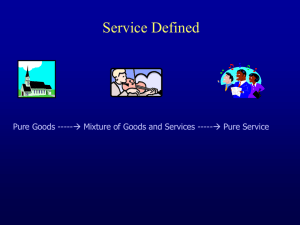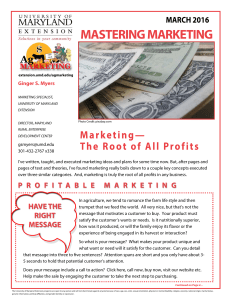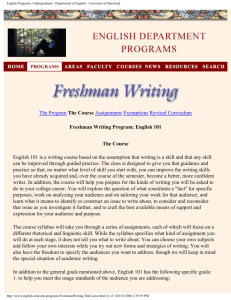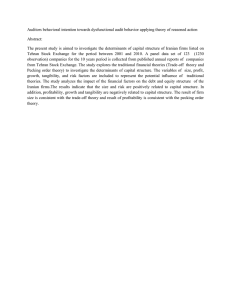Ag Marke ng NEWS UPDATE ‐ AUGUST 1, 2011
advertisement
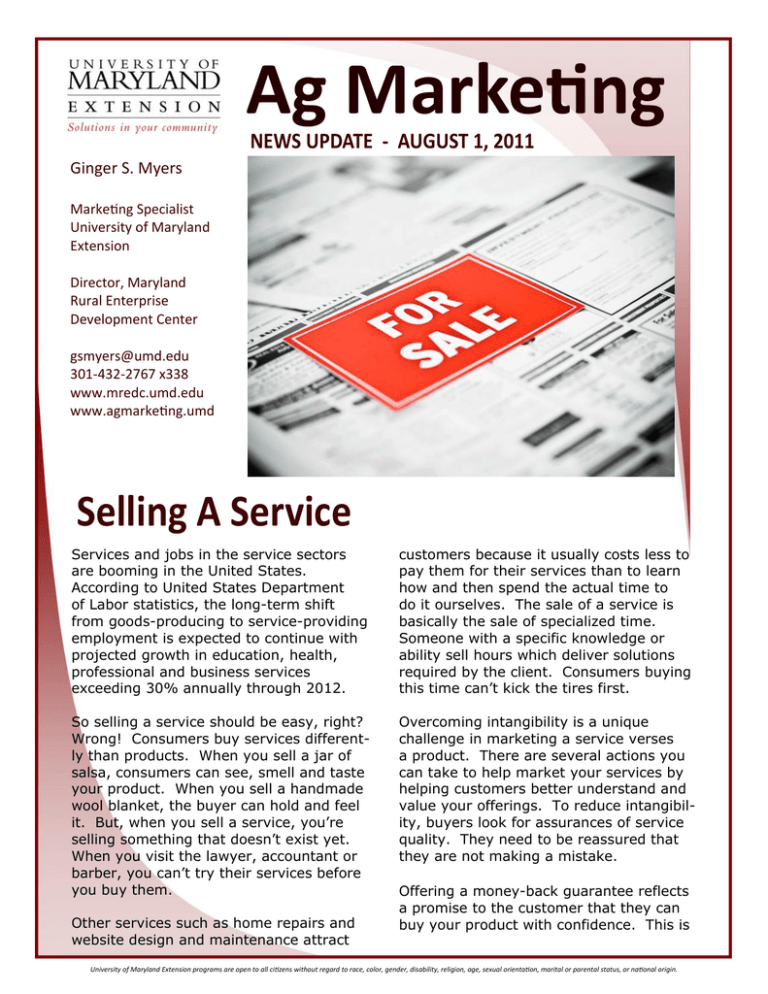
Ag Marke ng NEWS UPDATE ‐ AUGUST 1, 2011 Ginger S. Myers Marke ng Specialist University of Maryland Extension Director, Maryland Rural Enterprise Development Center gsmyers@umd.edu 301‐432‐2767 x338 www.mredc.umd.edu www.agmarke ng.umd Selling A Service Services and jobs in the service sectors are booming in the United States. According to United States Department of Labor statistics, the long-term shift from goods-producing to service-providing employment is expected to continue with projected growth in education, health, professional and business services exceeding 30% annually through 2012. customers because it usually costs less to pay them for their services than to learn how and then spend the actual time to do it ourselves. The sale of a service is basically the sale of specialized time. Someone with a specific knowledge or ability sell hours which deliver solutions required by the client. Consumers buying this time can’t kick the tires first. So selling a service should be easy, right? Wrong! Consumers buy services differently than products. When you sell a jar of salsa, consumers can see, smell and taste your product. When you sell a handmade wool blanket, the buyer can hold and feel it. But, when you sell a service, you’re selling something that doesn’t exist yet. When you visit the lawyer, accountant or barber, you can’t try their services before you buy them. Overcoming intangibility is a unique challenge in marketing a service verses a product. There are several actions you can take to help market your services by helping customers better understand and value your offerings. To reduce intangibility, buyers look for assurances of service quality. They need to be reassured that they are not making a mistake. Other services such as home repairs and website design and maintenance attract Offering a money-back guarantee reflects a promise to the customer that they can buy your product with confidence. This is University of Maryland Extension programs are open to all ciƟzens without regard to race, color, gender, disability, religion, age, sexual orientaƟon, marital or parental status, or naƟonal origin. Selling a Service con nued from page 1 ... especially important when marketing services on-line where customers might perceive internet sales as risky. Companies that guarantee to do a job right the first time or do it over with no questions asked, help customers buy with confidence. It’s smart to include a deadline with your guarantee though. Otherwise, some folks can abuse it months after the service was rendered. If you’re a new business owner, you may have to practice some generosity to get customers to try your service. Whether you’re operating a custom spraying business or offering hay rides, giving a free “trial” may recruit new customers. If satisfied with the service, these folks can also provide word of mouth advertising for you. Offering the “free trial” can be targeted to first-time buyers or can be used as part of a seasonal promotional campaign, such as a free hayride when you first visit the farm to pickyour-own strawberries. Service professionals, such as graphic artists, use portfolios of their work as evidence of service quality. Show potential customers photos of any completed projects, marketing brochures, ads and testimonials from satisfied customers to help reduce anxiety in the decision making process. These materials also work well for both face-to-face sales calls and in your web marketing plan. Any company whose services results in a physical product can add tangibility this way. Not all services produce a physical product that can be showcased. Mediators can’t show clients a resolved case. Service-based professionals can often add tangibility to their work by letting clients know what their credentials are. For example, doctors and lawyers almost always display their diplomas in their offices. Testing laboratories list their accreditations. If someone is a certified organic inspector, that information helps assure producers that the recommendations offered meet the National Organic Produc- tion Standards. As in all marketing, you need to differentiate your services from the rest of the pack. You can add tangibility to your service by providing a physical product with your service. Dentists often give patients a toothbrush after a checkup. Service companies give customers cups, caps or key chains; all embossed with their company’s name and often with their address and phone number. add tangibility to a service is with a letter. Services can send a thank you note detailing the service provided and thanking the customer. This note can also help differentiate your company from others in the customers mind. When insurance agents or real estate agents send you a calendar, they are providing a reminder of the services they provide. Because services are intangible, people may not always know what went into the service or when they may need to use it. When Jiffy Lube puts a reminder sticker in your window, it not only tells you when your next oil change is due, but adds perceived professionalism to their services. One of the great things about selling the intangible is it has the ability to change and grow on the spot. Your service can change and improve overnight. Most niche marketing involves staying ahead of the curve when it comes to what customers want. In a service business you can ask your customers, “What am I doing right?” and “What needs to be improved?” Then you can put those changes into effect immediately. If you religiously collect input from your customers, your service will constantly improve and you’ll garner a wealth of ideas on how to make the invisible more tangible. A very economical way to University of Maryland Extension programs are open to all ciƟzens without regard to race, color, gender, disability, religion, age, sexual orientaƟon, marital or parental status, or naƟonal origin.
